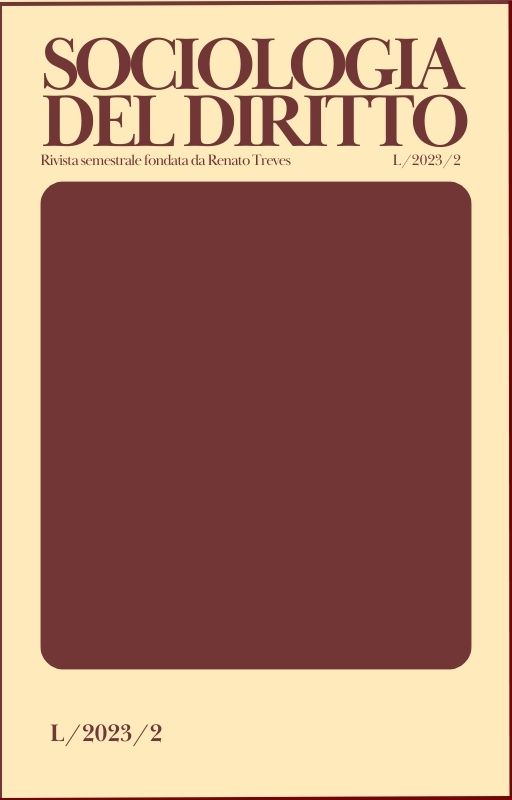Saggi
Pubblicato 2023-12-05
Parole chiave
- cambiamento climatico,
- tempo giuridico,
- diritto privato,
- proprietà,
- beni comuni
Copyright (c) 2023 Veronica Pecile

Questo lavoro è fornito con la licenza Creative Commons Attribuzione - Condividi allo stesso modo 4.0.
Abstract
In questo contributo si introduce un approccio temporale al diritto come potenzialmente innovativo per la teoria e la pratica giuridica. Si sostiene che un’analisi del rapporto tra diritto e tempo sia cruciale per attuare un decentramento del soggetto convenzionalmente inteso nel diritto moderno occidentale e per concepire strumenti giuridici in grado di riconoscere reti, legami e assemblaggi. L’attuale fase di cambiamento climatico e crisi ecologica viene interpretata come un contesto in cui è possibile ripensare le forme giuridiche fondamentali del diritto moderno, e del diritto privato in particolare, per consentire l’ingresso di temporalità non lineari e non umane nel pensiero e nella tecnica giuridica.
Downloads
I dati di download non sono ancora disponibili.
Riferimenti bibliografici
- Bakhtin, M., (1981), The Dialogic Imagination: Four Essays, Austin, TX, University of Texas Press.
- Blank, Y., Rosen-Zvi, I., (2010), The Spatial Turn in Legal Theory, HAGAR Studies in Culture, Polity and Identities, 10, 1, pp. 37-60. DOI: https://ssrn.com/abstract=2937221.
- Blomley, N., (1994), Law, Space, and the Geographies of Power. New York e Londra, Guilford Press.
- Chakrabarty, D., (2021), The Climate of History in a Planetary Age, Chicago, IL, University of Chicago Press.
- Code de l’environnement, (2022), https://www.legifrance.gouv.fr/codes/article_lc/LEGIARTI000045213769 (Data di accesso: 6/11/2023).
- Commissione Rodotà, (2010), Relazione per la modifica delle norme del codice civile in materia di beni pubblici, http://www.senato.it/service/PDF/PDFServer/DF/217244.pdf (Data di accesso: 7/09/2023).
- Crutzen, P., Stoermer, O., (2000), The Anthropocene, Global Change Newsletter, 41, 1, pp. 17-18.
- Cullmann, O., [1964] (2018), Christ and Time: The Primitive Christian Conception of Time and History, 3rd Edition, Eugene, OR, Wipf and Stock Publishers.
- Grear, A., (2015), Deconstructing Anthropos: A Critical Legal Reflection on ‘Anthropocentric’ Law and Anthropocene ‘Humanity’, Law and Critique, 26, 3, pp. 225-49.
- Greenhouse, C.J., (1989), Just in Time: Temporality and the Cultural Legitimation of Law, The Yale Law Journal, 98, 8, pp. 1631-51.
- Greenhouse, C.J., (1996), A Moment’s Notice: Time Politics Across Cultures, Ithaca, NY, Cornell University Press.
- Knop, K., Riles, A., (2017), Space, Time, and Historical Injustice: A Feminist Conflict-of-Laws Approach to the Comfort Women Agreement, Cornell Law Review, 102, 4, pp. 853-928.
- Koselleck, R., (1985), Futures Past: On the Semantics of Historical Time, Cambridge, MA, MIT Press.
- Kracauer, S., (1966), Time and History, History and Theory, 6, pp. 65-78.
- Jasanoff, S., (2010), A New Climate for Society, Theory, Culture & Society, 27, 2-3, pp. 233-53. DOI: https://doi.org/10.1177/0263276409361497.
- Latour, B., [1993] (1995), Nous n’avons jamais été modernes: Essai d’anthropologie symétrique. Traduzione italiana Non siamo mai stati moderni, Milano, Elèuthera.
- Marella, M.R., (2021), An Anthropology of the Legal Subject: On the Transformation of a Legal Concept, Osservatorio del diritto civile e commerciale, 1, pp. 71-104.
- Massey, D., (2005), For Space, London, Sage.
- Menga, F., (2021). L’emergenza del futuro. I destini del pianeta e le responsabilità del presente, Roma, Donzelli.
- Merino, R., (2018), Reimagining the Nation-State: Indigenous Peoples and the Making of Plurinationalism in Latin America, Leiden Journal of International Law, 31, 4, pp. 773-92.
- Monterossi, M.W., (2020), L’orizzonte intergenerazionale del diritto civile. Tutela, soggettività, azione, Pisa, ETS Edizioni.
- Napoli, P., (2014), Indisponibilité, service public, usage. Trois concepts fondamentaux pour le ‘commun’ et les ‘biens communs’, Tracés. Revue de Sciences humaines, 27, pp. 211-33. DOI : https://doi.org/10.4000/traces.6139.
- Napoli, P., (2015), Il Comune: un’appartenenza non proprietaria, Alfabeta2, http://www.alfabeta2.it/2015/04/25/il-comune-unappartenenza-non-proprietaria/ (data di accesso: 7/09/2023).
- Nuzzo, L., (2011), A Dark Side of the Western Legal Modernity: The Colonial Law and its Subject, Zeitschrift für Neuere Rechtsgeschichte, 33, 3-4, pp. 205-22.
- O’Donnell, E.L., Talbot-Jones, J., (2018), Creating legal rights for rivers: lessons from Australia, New Zealand, and India, Ecology and Society, 23, 1. DOI: https://doi.org/10.5751/ES-09854-230107.
- Orestano, R., (1968), Il problema delle persone giuridiche in diritto romano, Torino, Giappichelli.
- Pecile, V., (2021), The Legal Field as Battleground for Social Struggle: Reclaiming Law from the Margins, Oñati Socio-Legal Series, 11, 6, pp. 187-208. DOI: https://doi.org/10.35295/osls.iisl/0000-0000-0000-1248.
- Petersmann, M.C., (2022), Life Beyond the Law – From the ‘Living Constitution’ to the ‘Constitution of the Living’, Zeitschrift Für Ausländisches Öffentliches Recht Und Völkerrecht / Heidelberg Journal of International Law, 82, 4, pp. 769-800. DOI: https://doi.org/10.17104/0044-2348-2022-4-769.
- Richardson, B.J., (2017), Doing Time-The Temporalities of Environmental Law, in Kotzé, L., ed., Environmental Law and Governance for the Anthropocene, London, Bloomsbury Publishing, pp. 55-74.
- Scott, J.C., (1998), Seeing like a State: How Certain Schemes to Improve the Human Condition Have Failed, New Haven, CT, Yale University Press.
- Spanò, M., (2019), Making the Multiple: Towards a Trans-Subjective Private Law, The South Atlantic Quarterly, 118, 4, pp. 839-855.
- Spanò, M., (2020), ‘Perché non rendi poi quel che prometti allor?’ Tecniche e ideologie della giuridificazione della natura, in Spanò, M, ed., L’istituzione della natura, Macerata, Quodlibet, pp. 103-24.
- Spanò, M., (2022), Fare il molteplice: il diritto privato alla prova del comune, Turin, Rosenberg & Sellier.
- Stone, C.D., (1972), Should Trees Have Standing? Toward Legal Rights for Natural Objects, Southern California Law Review, 45, pp. 450-501.
- Tanasescu, M., (2022), Understanding the Rights of Nature: A Critical Introduction, Bielefeld, Transcript Verlag.
- Terré, F., (2012), Du juridique et du social, Parigi, Mare et Martin.
- Thomas, Y., (2002), La valeur des choses. Le droit romain hors la religion, Annales. Histoire, Sciences Sociales, 57, 6, pp. 1431-62.
- Thompson, E.P., (1967), Time, Work-Discipline, and Industrial Capitalism, Past & Present, 38, pp. 56-97.
- Valverde, M., (2014), “Time Thickens, Takes on Flesh”: Spatiotemporal Dynamics in Law, in Braverman, I., Blomley, N., Delaney, D., Kedar, A., eds., The Expanding Spaces of Law, Redwood City, CA, Stanford University Press, pp. 53-76.
- Valverde, M., (2015), Chronotopes of Law: Jurisdiction, Scale and Governance, New York, Routledge.

